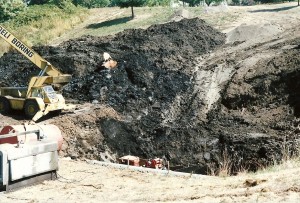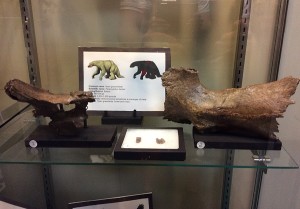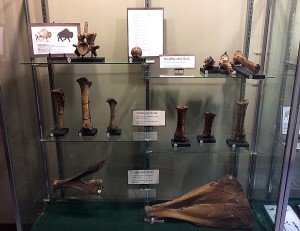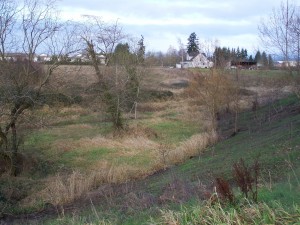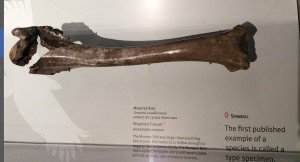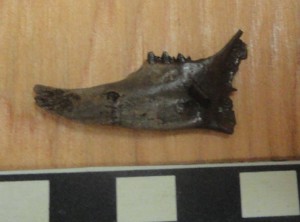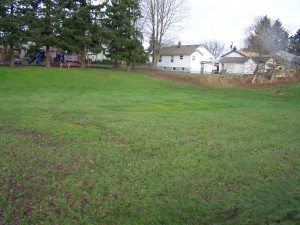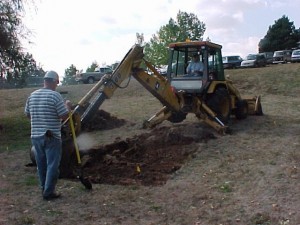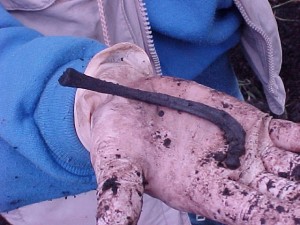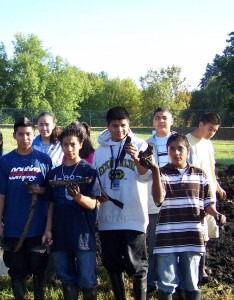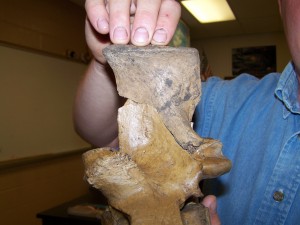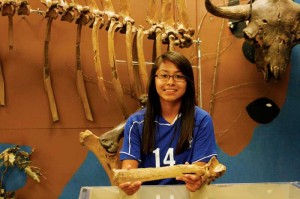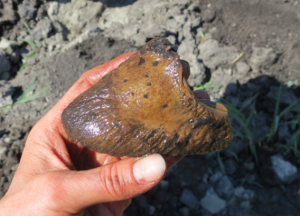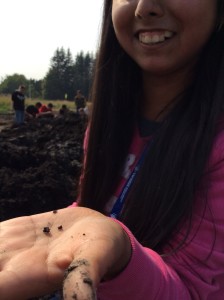A History of the Digs
Over the last 25 years professional and amateur paleontologists have been coming to Woodburn, Oregon to look for the bones of ice age animals. Like many other places around the Willamette Valley the discovery of ice age bones in Woodburn was by accident. Some have called Woodburn the LaBrea of the Northwest because of the rich supply of animal and plant fossils. The fossils from these digs have helped in the understanding of what Woodburn looked like during the late Pleistocene. They have also added to the overall story of what the end of the ice age was like in Oregon and the Pacific Northwest. The majority of the fossils from these digs are located at three places: Woodburn Public Library, Woodburn High School, and the Condon Museum at the University of Oregon. What follows is a brief explanation of the digs that have occured in the last 25 years.
An Accidental Discovery
In 1987 sewer line repair work was being done throughout Woodburn along the Mill Creek. This work included construction workers digging a 20 foot trench through the soft soil of the creek. While working near the High School, large bones were discovered. Worried that this discovery might slow down the work, many of the bones were taken home by the construction workers. However, a few of the workers returned some of the bones to the city where Dr. William Orr of the University of Oregon identified the bones as late Pleistocene mammals. These include: bison, giant ground sloth, sheep and horse. Some of these bones are now on display at Woodburn Public Library.
The Professionals Arrive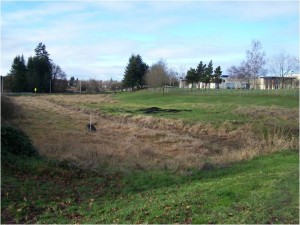
In 1996 the Institute for Archaeological Studies (IAS) under the direction of Drs. Alison Stenger and Chuck Hibbs wanted to investigate the site where the bones were found in 1987. Unfortunately, because of the sites proximity to a roadway the team could not access the exact location. Instead, they began doing some coring to determine the soil stratigraphy of the area. What they discovered would keep paleontologists coming to Woodburn for many years. About six feet below the surface exists an ancient bog. Within those soil deposits are the amazingly preserved remains of plants and animals. Trenches were dug later in the summer to get a better idea of the stratigraphy of the area. The following is a description of the soils provided by Dr. Stenger.
General Stratigraphic Information: Woodburn High School and Legion Park
Stratum 1 (surface soil): top soil and fill dirt
Stratum 2: Blue-clay layer
Stratum 3A: Forest material, with spruce, fir, but also willow and maple.
Stratum 3B: peat bog, stratified! Dates 10,800 yBP.
End of the Pleistocene
Stratum 3C: medium (can be light or darker, but not as brown-black as stratum 4) desiccated bog material, without mica. Dates 11,900-11,200 yBP.
Stratum 4: dark (chocolate) brown desiccated bog material, with mica. The micaceous material may be transported by wind and water, and mixed into this stratum. Dates 12,200-11,900 yBP.
Stratum 5 (deepest): gray to gray-green or gray blue silty clay, usually with substantial mica. This is the last of the Missoula Flood episodes, and dates to 12, 310 yBP. It can have inclusions of wood, granitics, or even lithics. Some megafauna and avifauna, but in small quantities.
In 1997 IAS returned to the high school to begin using heavy equipment hoping to find something similar to what was found in 1987. Oregon Public Broadcasting was invited to film the dig. (Below is a link of their broadcast on Oregon Field Guide.) This dig and one done in 1998 showed the extensive nature of the ancient bog. Samples from the bog were collected and stored, while bones of small and large animals, including an elk tooth, beaver skull, and an egg shell were cataloged and placed in the Condon Museum at the University of Oregon. The richness of plant and small animal fossils was a welcomed surprise. Some of these are also on display at City Hall with the larger 1987 bones. The beaver skull is located at the high school.
http://www.opb.org/programs/ofg/segments/view/1280
Sometime after the 1997 dig, Dr. Robson Bonnichsen of the Center for the Study of First Americans (CSFA) was brought on board. Wanting to incorporate education into the research, he came to Woodburn High School to help students for the first time sift through the peat deposits from the ancient bog. At the time, CFSA was housed at Oregon State University, and in conjunction with the Science and Math Education Department at OSU, a grant from the National Science Foundation was applied for and received to help further the work on the site and to bring secondary education teachers on board to learn how to conduct research and apply that learning into classroom inquiry based science.
In July of 1999 IAS moved their dig site a quarter of a mile from the high school
to Legion Park, hoping that this site would provide a better sampling of
larger animal remains. They were rewarded by the discovery of a giant ice
age bird called a teratorn. This was the first recorded find of a teratorn in
the Pacific Northwest, which has a wingspan between 12-14 ft. After careful research, it was later determined that this bird was a new species, and was given the name Teratornis woodburnensis. The bones are currently being kept at the Condon Museum or on display at the Northwest Museum of Natural History in Eugene, Oregon.
In June 2000 OSU and CSFA sponsored their first dig with the NSF grant. The dig took place at the High School under the direction of Rob Bonnichsen and Cliff Hedland. Included in this dig were a dozen middle and high school teachers. Teachers collected soil samples to take back to their classrooms and use in science lessons. Although plant remains were in large supply, few animal remains were found. One elk metatarsal was found, and it is on display at the High School today.
From 2000-2003 IAS conducted more digs at Legion Park. Overall these digs provided a treasure trove of animal fossils. Besides the teratorn bones other bones of large mammals were found, including bison, camel, and horse. However, t a majority of the bones belonged to small mammals, birds, reptiles, and amphibians. Most of the bones found during the Legion park digs are located at the Condon Museum, but some are on display at the Woodburn Public Library.
In July 2001 IAS moved their dig once more to a small park along Front St. in Woodburn. The discovery of a human hair caused great excitement among the paleontologists. DNA analysis of the hair pointed to an unknown human population. Further research is needed to be done on this hair before any definitive statements can be made.
June of 2001 OSU conducted another dig a few miles north in the city of Hubbard. This site was located on private land. The most significant find in this dig, was a layer of Mazama ash about five feet from the surface. Mt. Mazama was the ancient volcano that is now Crater Lake. It erupted around 7,700 years ago, spreading ash for thousands of miles. This trench displayed a two inch deposit of the ash from that eruption. Many of the same teachers that participated in the 1999 dig also were on hand for this dig.
In June 2002 OSU moved their dig site to the south part of Woodburn along Hermanson street. New middle and high school teachers were invited to participate in the dig. Unfortunately, this site proved to be quite sterile of both plants and animals. In August of 2003 OSU sponsored one last dig at South of Hazelnut Street (Ledbetter site). Magnetometry was used to try to decide on a site. An anomaly was discovered in the data review and digging began. However, the anomaly proved to be a previous dig site done by construction workers years ago.
The Students Start Digging
Education has always been an important part of the digs in Woodburn. Involving students and community members has been a goal to help bring the field of paleontology to a more public light. In September 2002 IAS was invited to come to the high school to work together with students on a site on the northern side of the school property. This was a learning experience for the students as they were able to work closely with professional paleontologists. Bones of mammals and birds, as well as shell fragments and small rodents were collected. These are located at the Condon Museum. This experience helped the teachers at Woodburn High School prepare to start conducting their own digs.
At this point, all of the professional and educational groups had finished their work in Woodburn. In 2003 the high school under the direction of David Ellingson started doing digs with the help of the City Water Department. The first dig was done on the north west corner of the west side of Mill Creek. Each September the digs would move south following the creek. In each dig samples of leaves, seeds, wood, and cones as well as the bones of small and large animals were discovered. The most exciting discovery was made in 2006 of a bison mandible that showed extreme wear on the molars. A more detailed summary of these finds can be found in the bog animals and bog plants sections of this web-site.
The largest find occurred in September of 2008, with the discovery of a Bison antiquus skeleton. The first bone that came up with the track hoe, was the right femur. The track hoe operator, Dan Jones of the City Water Department, stopped and removed the bone from the bucket. He then looked in the pit, and noticed a number of other bones lying on the bottom. However, because of the depth and instability of the walls of the pit the only way to bring the rest of bones to the surface was to use the track hoe. For the next week, students sorted through the soil and collected bones and fragments of bones. For a summary of what was found, please visit the Bison antiquus portion of the website.
The following September (2009) a trench was dug next to the 2008 site. As usual, bones of small mammals and birds were found. However, only one bone of the bison was discovered. It was a fragment of the spinous process of one of the lumbar vertebrae that fit perfectly into a vertebra found the previous year.
In August of 2010 IAS, who had been doing a lot of their work along the Yamhill River near McMinnville, was invited back to the High School. Dr. Stenger brought students from a Portland Community College class that she taught to help in the dig. Within the first few hours of digging, the skull of a bison was brought to the surface. However, it was in fragments. For the next week, students and volunteers worked through the soil using water screening to find over 500 pieces of the skull. A month later, when the high school students conducted their annual dig, the right humerus of a bison was found. All of these are on display at the High School.
August 2011 IAS returned to the high school with more PCC students. No parts of the bison were found, but many small rodents and bird bones, including a complete skull of a muskrat. In September, high school students found the first skull of a bird as well as some amazingly preserved leaves of pacific willow and pond weed. Since 2003 all plant an animal remains found in the digs have been kept at the High School. Many are on display and are being analyzed by students to help understand what Woodburn looked like at the end of the ice age.
August 13-20, 2012, IAS returned again to the high school with 11 students from PCC. A pit was opened about 25 feet from the creek. This site proved to be very rich in both mega and micro fauna. A total of 205 bones were found. These included 5-6 ribs of probable bison, a turkey humerus, 15 turtle shell fragments, and numerous muskrat and other rodent bones. The high school dig in September, was also very productive. The bottom half of a turtle carapace was found the first day. Over the week, more turtle bones (including a beak) were found. One exciting addition, was Doug Zade’s fifth grade class from Silverton who participated on one day. They were enthusiastic and even found a couple small rodent bones.
The 2013 digs were successful in finding more fossils. A complete thoracic vertebra of a bison was found. It was put together by Zulekia Vasquez, a senior at WeBSS. This vertebra was unique because it had a fused epiphysis at the top of the spinous process. This showed that this bison was an older animal. Also, the measurements were smaller than the thoracic vertebrae from the 2008 skeleton. Other fossil finds included a nearly complete muskrat skeleton, turtle shell fragments, long bones of a variety of ducks, rabbits, and the second shrew mandible. The groups involved in the dig included IAS, NARG, Linfield College, and a pre-school from Yamhill and a second visit by Doug Zade’s fifth grade class.. Many community members also participated in weekend digs.
the 2014 digs were also a successful year. Over 300 bones were found, and nearly 200 individuals were involved. More bison bones were found, including a second cervical vertebrae of a juvenile bison. Other bison bones included three toe bones and a complete rib. Some very large turtle shell fragments were also uncovered. In late August, Dr. Chris Shaw from the Page museum in Los Angeles visited the school. He was able to identify many bones that were unknown. One animal was the Leopard frog (Rana pipens). It turns out that many of the small, unknown bones belong to the Leopard frog, and may have been one of the most numerous animals present in the area. Dr. shaw also identified bones to rattlesnakes and alligator lizards. Together with Dr. Stenger and David Ellingson, a poster was made of the amphibians and reptiles from the digs and presented at the WAVP conference in February 2015.
